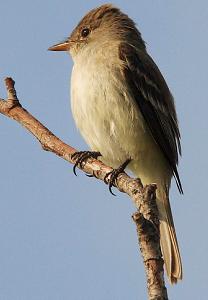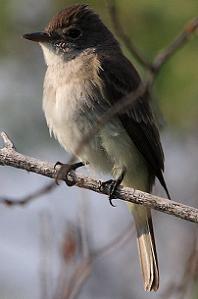Hammond's Flycatcher 
Identification and Pictures
(Empidonax hammondii)
Hammond's Flycatchers are small active
songbirds, about 5 1/2 inches. They have an olive brown
back, pale yellow belly, and gray breast. They have a
small pointed bill, almost like a Kinglet,
long wings with two white wing-bars, whitish under tail coverts,
and a whitish eye ring that is not visible in all birds.
Their legs, and feet are black. These birds flick their
wings and tail constantly. This is one bird that gives ornithologists
a headache since Hammond's and Dusky Flycatchers are extremely
difficult to tell apart. Dusky flycatchers have a
slightly longer tail, there is less contrast between the chest,
and belly, the under parts are not quite as yellow. They
have a weak fluttering flight with shallow wing beats.
Photos by Keith
Lee. The camera I use is the Canon
EOS 40D. Visit All-birds store Visit All-birds store
Sound
The song of Hammond's flycatcher is in 3
parts, something like sel-ip, twur, tree, and they have a call
that is a sharp pic. sound
Preferred Habitat
In summer they can be found from Alaska down
through Western Canada, and the U.S. They prefer
coniferous woodlands or mixed forests, usually staying high in
the canopy. They migrate south to Mexico, and Central
America for winter.
Breeding and Nesting
Like most songbirds the male sings to defend
his territory, and attract a mate. In early breeding season the males sometimes become locked in mid air as they fight.
The nest is a cup built by the female with grass, plant fiber,
pine needles, and twigs, lined with feathers, and other soft
material, on a high tree limb, out away from the trunk.
Females incubate 3 to 4 white, sometimes spotted eggs for
around 15 days. Both parents will feed the young birds
which will fledge in 16 to 18 days. The fledglings will
usually stay with the parents for another week.
Food
Flycatcher's main diet is insects such as
beetles, flies, bees, moths, and caterpillars. They are aerial
feeders, usually foraging high in the trees where they perch
on an open branch, and fly out to capture their prey.
They sometimes forage in lower vegetation or even on the
ground.
To learn about other favorite
birds click here.

|
